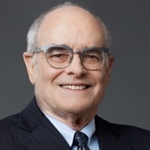Assets 2025: Interview with Tom Kline
Popular Tags

Sunday, March 16, 2025 in Education, Conference, Business Tips
Assets 2025 Speaker Interview: Thomas R. Kline in Conversation with Ashley Crawford (ISA AM)
We are very excited for the celebrated art lawyer Thomas R. Kline to join us at this year’s ISA Assets Conference to present his lecture Appraiser Self-Protection: Avoiding Title and Ownership Claims! In preparation for this general session presentation, Asian art specialist Ashley Crawford (ISA AM) met with Tom to learn more about his important work, the Washington DC art market, and what appraisers need to know about art law.
Ashley Crawford: Thank you for talking to us about art law at this year’s conference! You have had a prolific and international career covering many areas in the field. How did you first become an art lawyer?
Tom Kline: After attending law school and serving in a judicial clerkship, I came to Washington, DC to focus on federal policy issues. I started out in general litigation and for about a dozen years, that is where I stayed, in private practice and at the US Department of Justice. I was working in the Washington office of a private law firm that represented the Republic of Cyprus when four ancient and well-documented mosaic fragments stolen from a Church in the Turkish-occupied area of Cyprus appeared in the United States. US Customs Service refused to seize them, so the Republic and the Greek-Orthodox Church of Cyprus had to sue to get them back. The Cyprus Ambassador asked me to handle the case, which we did successfully. After that I was approached by a German provenance researcher who was looking for the famed treasures from the Lutheran Church of St. Servatius in Quedlinburg, which was initially the royal capital of Germany. The treasures disappeared in the closing days of World War II having been stolen by a US Army lieutenant from Texas. After we settled that case, I looked for other opportunities to handle art-related matters and that work gradually became most of my practice.
AC: That is such a fascinating start! Closer to home, what is working in DC like as an art lawyer?
TK: Washington is well known as a museum city with the Smithsonian’s 21 museums here, but there are also numerous private museums, most notably the Phillips Collection and the Corcoran and Textile Museum, which are now part of George Washington University. Washington is also home to numerous dealers and private collectors, although not on a scale of other major cities.
It is very challenging to practice art law in the Washington, DC, area, which is a center of national policy-making and has a concentration of government museums, but is not really a center of the art market. Compared to other business and legal centers, there are few private museums, major collectors and dealers. Parties interested in art law issues include embassies, congress and government offices, as well as dealers and collectors. As a result, most of my clients are located elsewhere. I started out representing German museums and other German cultural institutions in recovering their World War II losses and handling other cases for Cyprus. In the mid-1990s, I represented the plaintiffs in the first Holocaust-related art recovery case since the immediate post-War period and I eventually branched out to prosecuting and defending ownership claims and also handling authenticity issues, breach of contract and other market-related matters. I have also been able to teach art law and related ethical and moral issues at George Washington University, Museum Studies Program, to speak on art law panels and to write about these matters.
AC: It sounds like you have collaborated with many types of arts professionals throughout your career. In which contexts do art lawyers collaborate with appraisers?
TK: Art lawyers work with appraisers in a variety of contexts in which their clients require a reliable, accurate valuation for objects in dispute. As an example from my own practice, recently a non-profit organization needed an honest value to sell a musical instrument. Likewise, if an object is stolen, lost or destroyed, an accurate value is needed to support a theft report, claim for compensation against the wrongdoer or an insurance claim. Often, the law varies for low value objects at the time of a disputed transaction and in some cases, an expert may be needed to prepare an expert appraisal for a valuation at the time of a disputed past event. Working with appraisers, law enforcement offices often declare the value of seized or forfeited artwork. Lawyers may ask appraisers to testify about value in court or in an arbitration or other proceeding. In testifying, the expert will need to make clear that they followed industry standard ethical rules and procedures and did not reach any conclusions about ownership or authenticity. Such testimony would be undermined, if the appraiser ignored obvious red flags and took no steps to at least address apparent doubts about ownership or authenticity.
AC: Yes, that makes sense. It seems like there are more situations in which appraisers work with art lawyers than one might initially realize. You touched earlier on some cases regarding title and ownership/ cultural heritage, which you will also be talking more about during your presentation. Why should appraisers pay attention to these subjects?
TK: Appraisers know that they need to protect themselves by including provisions in their contracts with consignors in which the consignors guarantee that they own the property, are not aware of any defect in title and recognize that the appraiser is not giving an opinion about ownership or authenticity. Appraisers should use such provisions, but they must recognize that these clauses have only limited utility. The clauses do not protect against claims of deliberate, intentional wrongdoing. Nor can they be guaranteed to fend off claims by third parties. As a result, vigilance is needed to give appraisers belt and suspenders protection.
AC: This vigilance is definitely something we will all benefit from hearing more about during your presentation! Going back to your cultural heritage cases – these are often international by nature. As ISA is an international organization, how should we consider this aspect as appraisers when working on international assignments?
TK: International aspects can complicate matters. Any party engaged in international loans or transportation of objects has to recognize increased risk based on invocation of the laws of one or more other countries as well as US laws governing interstate and international transportation of stolen property. (The national boundary is also a state boundary.)
AC: All the more reason for appraisers to take care with title and ownership claims, I’m sure! Lastly, what’s your favorite case you’ve worked on and why?
TK: Even after all this time, my first two cases, Kanakaria Mosaics and Quedlinburg Treasures are still my favorites. Both cases involved looting of church property by notorious characters during armed hostilities. Since they were my first and second cases, I needed to consult many experts and to learn about the art world and disruptions caused by warfare. Each case involved interaction with government officials – foreign and domestic. In each case, there was a failed effort to involve law enforcement and serious efforts at private settlement which were ultimately successful in the Quedlinburg Treasures case. In each case, the value of the art objects was relevant to the case and was heavily covered in the press. In short, I started out with two ice baths, I got an in-depth introduction to art law disputes, particularly the unusual characters that one encounters and the central importance of working with experts, be they knowledgeable about archeology, World War II, the art market … or valuation of art objects.
AC: You have really given ISA appraisers a lot to think about before Conference! Thank you so much, Tom, for sharing your expertise with us and we look forward to your lecture on Saturday, 5 April.

Tom Kline, Of Counsel with Schindler Cohen & Hochman LLP, represents clients on art, cultural property and museum issues including providing advice, documenting transactions and handling claims and litigation. He is best known for such groundbreaking cases as Cyprus v. Goldberg (church mosaics stolen during Turkish occupation), Quedlinburg v. Meador (church treasures stolen by U.S. Army Lieutenant), Goodman v. Searle (claim of Nazi art theft), Vineberg v. Bissonnette (forced sale), and Republic of Turkey v. Christie’s (Stargazer Idol claimed unsuccessfully by Turkey). For nearly 20 years, Tom co-taught a seminar on Museums and Cultural Property as Professorial Lecturer in the Museum Studies Program, George Washington University. For protecting German Cultural Heritage, Tom was awarded the Officer’s Cross of the Order of Merit of the Federal Republic of Germany (Das Verdienstkreuz des Verdienstordens) and has also received the Medal of Cyprus Technical University for protecting the cultural heritage of Cyprus.

Ashley Crawford is the founder of the appraisal firm Ashley Asian Art and is an experienced Asian art specialist and provenance researcher. Her specialties include Buddhist antiques, ceramics, Indian miniature paintings, and musical instruments. Originally from San Francisco, she now spends her time between the US and London. Ashley holds two degrees in Asian art history from the School of Oriental and African Studies, University of London, both with high distinction. Previously, she earned degrees in musicology at Scripps College and Christ Church, University of Oxford. She is the current chair of ISA’s Antiques, Furniture, and Decorative Arts Committee (AFDA) and serves on the Conference Committee.
Register for this year’s ISA conference here.
